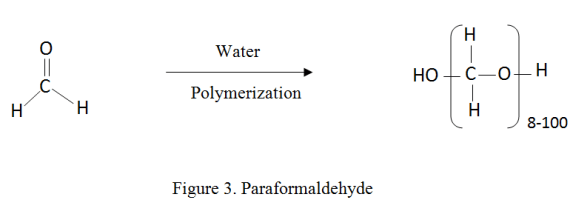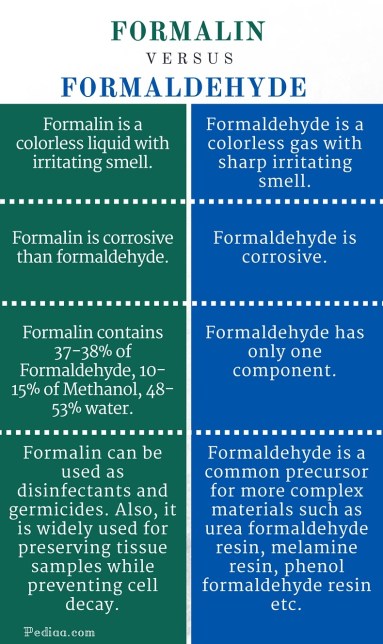主な違い – ホルマリン vs ホルムアルデヒド
ホルマリンとホルムアルデヒドは、どちらもCH2Oで表される同じ化学式を持っています。
しかし、その物理的な状態や化学的な活性にいくつかの違いがあります。
基本的にホルムアルデヒドは常温では無色透明の水溶性可燃性気体で、鋭い刺激臭があります。
しかし、ホルマリンは液体であり、ホルムアルデヒドガスと水を混合して調製されます。
ここがホルマリンとホルムアルデヒドの大きな違いです。
一般にホルマリンの飽和溶液には、約40%(体積比)または37%(重量比)のホルムアルデヒドガスと、ホルムアルデヒドの重合を防止するための安定化剤が含まれています。
ホルムアルデヒドとは
Formaldehyde is the simplest aldehyde with the chemical formula CH2O, and its IUPAC name is Methanal. Other than the IUPAC name, formaldehyde is also known as Formol, Formic aldehyde, Methaldehyde, Morbicid, Paraform, Methylene oxide, Oxymethylene, Oxomethane, etc. Its boiling point is -19.5 oC. Therefore, it exists as a colorless gas at room temperature with a pungent odor. This gas appears in the environment as a result of natural processes or man-made sources, such as photochemical oxidation and incomplete combustion of hydrocarbons. Formaldehyde has trigonal planar structure, and it belongs to C2v point group. The Figure 1. and 2. Illustrate the structure and hybridization of the bonds in formaldehyde.
ホルムアルデヒドは、水やエーテル、アセトン、ベンゼン、アルコールなどの有機溶媒に非常によく溶ける。
溶解性以外に、過塩素酸、アニリン、過酢酸、ニトロメタン、炭酸マグネシウム、過酸化水素などと急速に反応します。
ホルムアルデヒドは哺乳類に急性作用を及ぼし、その高濃度を吸入すると、唾液過多、急性呼吸困難、嘔吐、筋痙攣、痙攣を起こし、最終的に死亡する。
反応性の高いガスであるため、接触した時点で容易に吸収される。
弱い遺伝毒性とはいえ、哺乳類の細胞で遺伝子変異を誘発する能力があります。
しかし、ホルムアルデヒドは光分解や生分解を受けやすく、二酸化炭素と水が発生する。
ホルマリンとは
ホルマリン
Formalin is a saturated solution of formaldehyde gas in water. It contains about 40% (by volume) or 37% (by weight) formaldehyde gas along with a small amount of stabilizer. Here, the general stabilizer is 10-12% methanol, and it is useful to prevent the formaldehyde polymerization. Without stabilizer, formaldehyde solution is very unstable, and it tends to polymerize, forming macromolecules that are insoluble. Complete hydration of formaldehyde gas mostly yields methylene glycol. Subsequently, it leads to the production of paraformaldehyde by polymerization. The Figure 3. Illustrates the structure of paraformaldehyde.
ホルマリンに重合防止用のメタノールを加えたもの。
ホルマリンは無色の液体です。
ホルムアルデヒドの発散により、鋭い刺激臭があります。
PH値は中性ですが、還元剤として作用し、蟻酸を生成しながら他の物質を還元します。
強ホルマリン溶液は可燃性です。
この溶液は、有害な微生物を破壊することができるため、消毒剤、殺菌剤として使用することができます。
その他、脱水作用、保存性、またタンパク質と結合して不活性化し、細胞を死滅させることができる。
このような性質から、水族館では魚に寄生する寄生虫を殺すためにホルマリンがよく使われる。
ここでは、魚に害を与えないようにホルマリンを薄めた溶液を使用します。
ホルマリンとホルムアルデヒドの違い
物理的な性質
| 物性|ホルマリン|ホルムアルデヒド|の違い
| 物理的状態|無色の液体で刺激臭がある|無色の気体で鋭い刺激臭がある
| 蒸気圧(mmHg):20℃、67-88、>760
| 沸点(℃):91-101℃(-19℃)。
| 引火点:56℃、64
| 腐食性:ホルムアルデヒドより腐食性が高い。
化学組成
ホルマリン ホルマリンは、37-38%のホルムアルデヒド、10-15%のメタノール、48-53%の水を含んでいます。
ホルムアルデヒド: 純粋なホルムアルデヒド(1成分のみ)
用途
ホルマリン。
ホルマリンは、殺菌剤、殺虫剤として使用できる。
また、細胞の腐敗を防ぎ、組織試料の保存にも広く利用されている。
Formaldehyde: Formaldehyde is a common precursor for more complex materials such as urea formaldehyde resin, melamine resin, phenol formaldehyde resin, polyoxymethylene plastics, 1,4-butanediol, and methylene diphenyl diisocyanate. These polymers are mostly used in textile industry as a finisher, and as permanent adhesives in plywood and carpet. Furthermore, formaldehyde is a precursor to polyfunctional alcohols, which is used to make paints and explosives.
